
Solar and Lunar Eclipses
Our Moon is responsible for producing some of the most historically significant and awe-inspiring events in astronomy. The Moon’s changing phases over a 29 – 30 day cycle have long captivated the attention of professional and amateur astronomers alike. The fact that this huge object in the sky can undergo such significant apparent changes from one day to the next baffled early astronomers and led to a wide range of mythologies and stories from beliefs based on the idea that the Moon was actually changing its size each day. My personal favorite story relating to the Moon’s changing appearance comes from the Aborigines, native to Australia. One tribe saw the phases of the Moon as a husband who was lazy and ate too much and was constantly getting bigger and bigger for 14 days until his wife had had enough of him and started chopping him into pieces, making him smaller and smaller over the next 14 days. Of course, we now know that the phases of the Moon do not come from the Moon actually physically changing its size or shape each day in its cycle or a even a vengeful wife, but rather from the orbit of the Moon around the Earth and how different amounts of the side of the Moon lit by the Sun are visible from here on Earth. For much more detail on the phases of the Moon, read the companion article in this section.
An even more awe-inspiring and seemingly random event produced by the Moon created even more fear and anxiety from ancient peoples. Those events were eclipses, especially solar eclipses. Imagine going about your daily business and suddenly seeing the sky darken as the Sun begins to disappear. Imagine up to 7 minutes of complete unknown when the Sun is completely gone and stars have invaded the daytime sky. Then imagine the relief as the Sun slowly starts to reappear and eventually goes back to its normal appearance. That is what a solar eclipse is like, and while in our current times it is neither mysterious (since we know exactly what is producing an eclipse) or unexpected and random (since we can predict eclipses for millennia to come); ask anyone who has seen an eclipse, particularly a total solar eclipse, and they will tell you that it is just as awe-inspiring as it was thousands of years ago to those first astronomers.
If you are studying eclipses in your Introductory Astronomy class, while you will undoubtedly find them spectacular and amazing sights to behold, you may also face them with a different fear and trepidation that the ancient peoples felt. Eclipses can be tricky concepts to learn about, especially with their very specific terminology. Don’t face these events on your own. Let us at 24houranswers.com help you learn this material. We have tutors who specialize in all facets of astronomy, from introductory astronomy topics such as eclipses to graduate level material. We can help make the seemingly difficult topics of astronomy second-nature to you. Reach out to us today and let us help you.
Solar Eclipses
There are two main types of eclipses – solar and lunar. They are fundamentally different in the effects they have on the Earth, their rarity for observers, and their causes, but what unites them is that both kind of eclipses involve the Sun, Moon, and Earth and one object (either the Earth or Moon) blocking light from reaching the other object (the Earth or Moon). Let’s discuss first the ones that are honestly more exciting, the solar eclipses. Solar eclipses are the much rarer to see events where the Sun can seem to disappear from the sky and stars are visible during the daytime. What causes a solar eclipse? A solar eclipse occurs when the Moon is directly in between the Earth and the Sun. When this occurs, part of the Moon’s shadow (also called its umbra) manages to fall on the Earth. Just as it is darker and you cannot see the Sun if you are in the shadow of a building or tree, it is darker and the Sun is blocked out when you are in the umbra of the Moon. Consider the image below, which it should be noted is not even close to scale. The Sun is actually about 150 times farther away from the Earth than shown in the picture and also approximately 150 times bigger in diameter! In the image, the solid black region is the Moon’s umbra and the area where the umbra is hitting the Earth is experiencing a total solar eclipse.
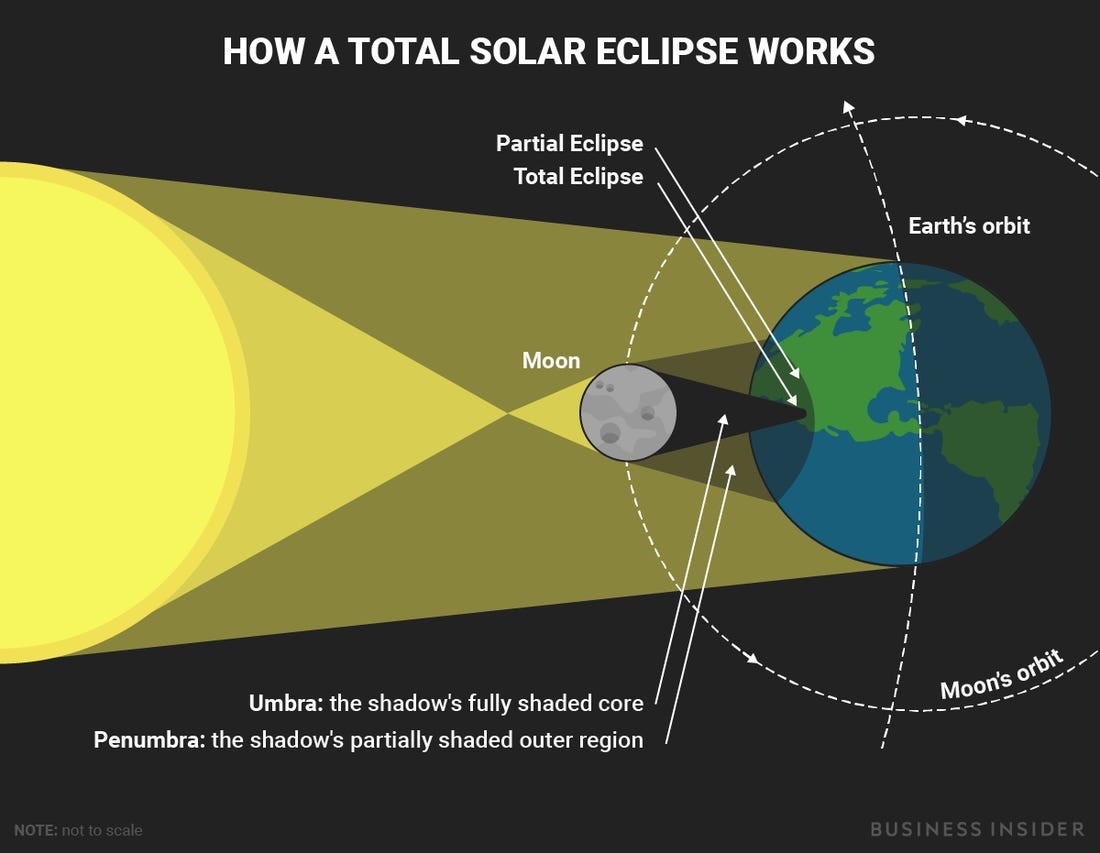
(https://www.businessinsider.com/solar-eclipse-diagram-2017-8)
Total Solar Eclipses. What is a total solar eclipse? A total solar eclipse is what everyone thinks about when they imagine a solar eclipse. It is where the Sun is completely blocked by the Moon. The sky goes completely dark. Stars are visible in the middle of the daytime. Animals get very confused and often panicked. Notice, however, in the diagram how small the Moon’s umbra actually is when it hits the Earth. It is only a very small area that is located in the umbra at any given time. In fact the region that can see a total eclipse at any given moment is always less than 150 miles across, and that is a maximum size if conditions are perfect for a solar eclipse. In practice, the area can be fifty to one hundred miles or even smaller. As we will see later, the primary determining factor in the size of the Moon’s umbra on the Earth and the region on Earth that can see a total eclipse at the same time is the distance from the Earth to the Moon. The closer the Moon is to the Earth, the larger its shadow is and the bigger area that can see the total solar eclipse. This fact is visible in the diagram above. The shadow of the Moon is cone-shaped, and if we imagined moving the Earth closer to the Moon, the Earth would intercept the cone closer to its opening at the left, which means a larger cross-section and more area to see the total solar eclipse.
Total solar eclipses also do not last very long, helping to contribute to the mystery and excitement of the event. The longest a total solar eclipse can last at any one location is 7 minutes, but in practice it can be as short as a few seconds of totality! Why the difference? To understand the difference we need to understand first why the eclipse only lasts for a set amount of time in the first place. The whole time the eclipse is occurring, the Earth is still rotating and even more importantly the Moon is still orbiting the Earth. As it orbits the Earth, the exact location of the Moon’s umbra will move through space, and different parts of the Earth will be in the area of a total eclipse. Indeed it is the motion of the Moon that drives the motion of the eclipse, even more so than the fact that the Earth is also rotating at the same time.
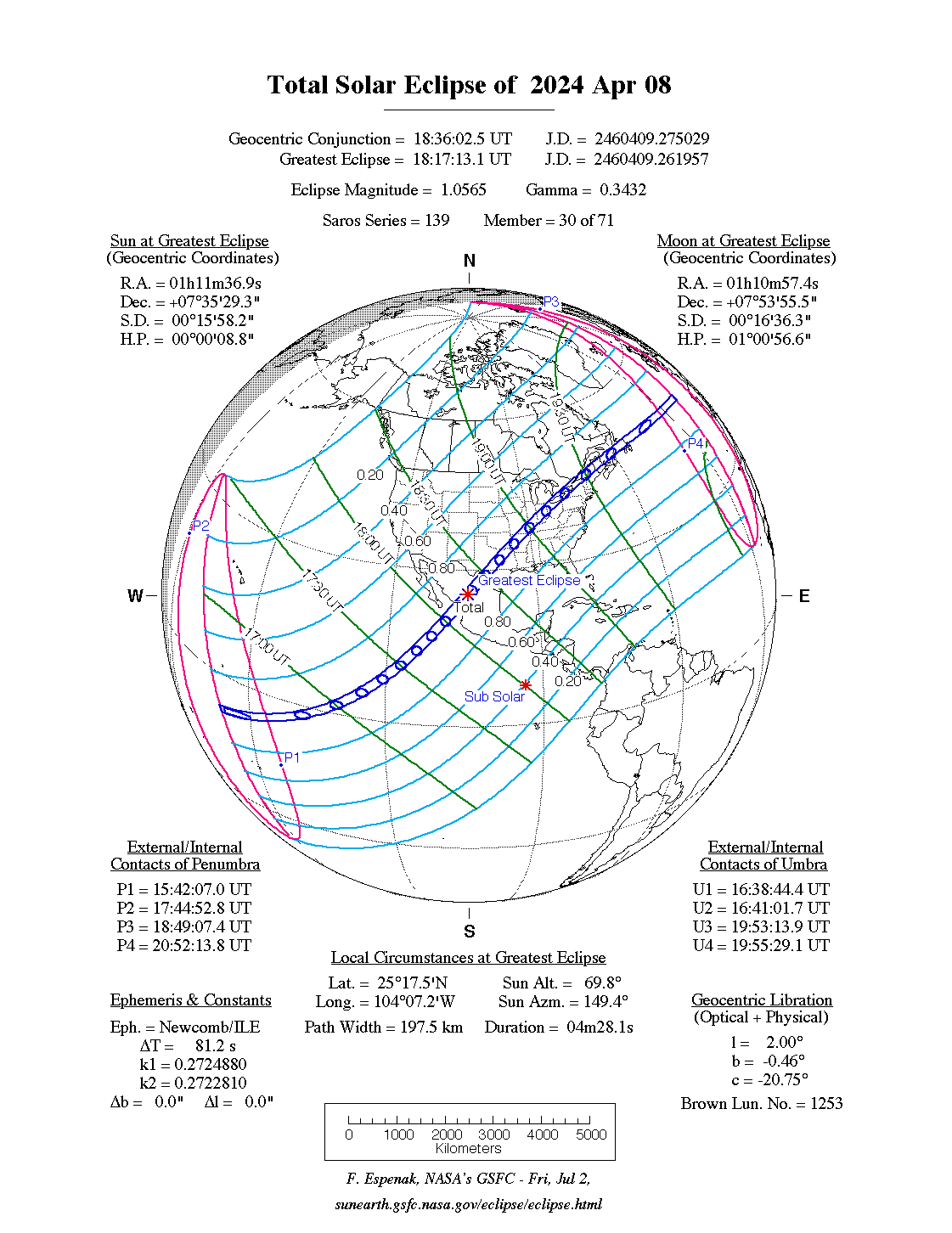
(https://eclipse.gsfc.nasa.gov/SEplot/SEplot2001/SE2024Apr08T.GIF)
Consider the image above of an eclipse occurring in 2024 in the United States. The dark blue lines show the reader the area where a total eclipse will occur, starting with the area farthest to the west and moving from west to east (or left to right) across the image. This particular eclipse appears to begin over the Pacific Ocean, travel through Mexico, and then enter the United States in Texas. From there it goes through the Midwest and Northeast before leaving the United States in New England and then Canada and the Atlantic Ocean. The total eclipse travels this entire path in just over 3 hours, traveling at approximately 1000 - 2000 miles per hour. If it were only the rotation of Earth causing the eclipse to move, the speed would be closer to 1000 miles per hour if you were at the equator and even slower away from the equator, and in fact the eclipse would also seem to move in the opposite direction! The fact that the Earth is rotating actually serves to work against the movement of the Moon in its orbit and causes total eclipses to last longer than they would if it wasn’t for the Earth’s rotation. Nevertheless, even at the slower speed for the eclipse of a little over 1000 miles per hour, this still far exceeds commercial aviation capabilities or the speeds of any but supersonic jets. Therefore it is not possible for the average person to “follow” an eclipse. You might as well stay in the place you are observing it. How long the eclipse lasts again depends on the distance of the Moon from the Earth. The closer the Moon is to the Earth, the longer the eclipse lasts. There is one way, however, that you can easily impact the time of the total eclipse, also known as the duration of totality. This is to make sure that you are viewing the eclipse from as close to the eclipse center as possible. If you imagine the Moon’s umbra as this circle that is moving across the face of the Earth, the closer you are to the middle part of that circle, the longer you will stay in darkness. When an eclipse is described as having 5 minutes or 2 minutes of totality, it is being measured for an observer at the center of that eclipse. Move away from the center and the duration of totality will decrease until ultimately one reaches the boundary of the Moon’s umbra and the total eclipse only lasts for a second or less.
What does it look like to experience a total solar eclipse? The entire process can easily take over 2 hours and provides a dramatic light show not only during the total eclipse but also in the time leading up to it and immediately following the totality time. The process begins with what is known as a partial eclipse. A partial eclipse is when some, but not all, of the Sun is blocked by the Moon. At first, only an imperceptible fraction of the Sun is blocked (the moment the eclipse starts is known as first contact) but over the course of what can be as long as an hour or more, more and more of the Sun is gradually blocked. Pretty early on the effect becomes noticeable, and a view of the Sun through a safe device shows a portion of the Sun removed as the Moon has started to block it. The sky will begin to darken slightly – not a complete darkness – this is reserved for the total eclipse time – and the temperatures will start to drop a small amount, almost like temperatures will momentarily get cooler if the Sun disappears behind a cloud for instance. Once the Moon begins to cover 90 – 95% of the Sun, the time of totality is quickly approaching. The period of totality begins when the face of the Moon completely covers up the Sun, known as second contact. However, the Sun might not have completely disappeared at this point. The mountains and valleys of the Moon mean that even if the main part of the Moon is blocking the Sun, sunlight could still get through a low point on the edge of the Moon’s face. This light from the very little bit of the Sun that is still visible fans out in the small area not covered by the Moon, and that fanning out looks like a diamond. The technical term for this phenomenon is Baily’s Beads. However, the combination of the main sunlight breaking through the valleys of the Moon and the emerging view of the Sun’s corona and chromosphere (which we will discuss next), makes the eclipse appear to have a bright spot (the “diamond”) and a ring of faint light surrounding the Moon, causing this time to be more commonly known as a Diamond Ring. The Diamond Ring is very short-lived – typically only a second or two and then true totality begins. At this point the sky appears to go dark and stars are visible in the sky, even around the area where the Moon is blocking the Sun. This is the only time when it is safe to look at the eclipse without any protective eye gear – any other time when even a small bit of the Sun’s main face (called the photosphere) is visible, that light from the Sun can cause eye damage if stared at for too long or even if only glimpsed for a second through an unprotected telescope or binoculars. During the totality of the eclipse, the sky is not completely dark, however, around the Moon and Sun area. A thin ring of light is often visible around the Moon. This is the chromosphere of the Sun. The chromosphere, the inner part of the Sun’s atmosphere, is always there, glowing with a faint pink color because temperatures in the photosphere are just right to enable the hydrogen gas located there to move into an excited state and then fall back toward ground state, producing light that is pinkish in color. Even though the chromosphere is always there, it is so faint compared to the photosphere of the Sun that its light gets drowned out by the photosphere if even a tiny amount of the main part of the Sun is visible. Surrounding the chromosphere is another part of the Sun’s atmosphere, the corona or “crown” of the Sun. The corona is made up of very hot gasses, often in the millions of degrees range. As the gas in the corona is not densely packed together like the main portion of the Sun, the overall amount of light produced by the corona is small, and just like the chromosphere, the corona is only visible when the photosphere of the Sun is completely blocked. After totality is completed, the process undoes itself, this time on the other side of the Sun. A diamond ring may briefly appear (with the diamond now found
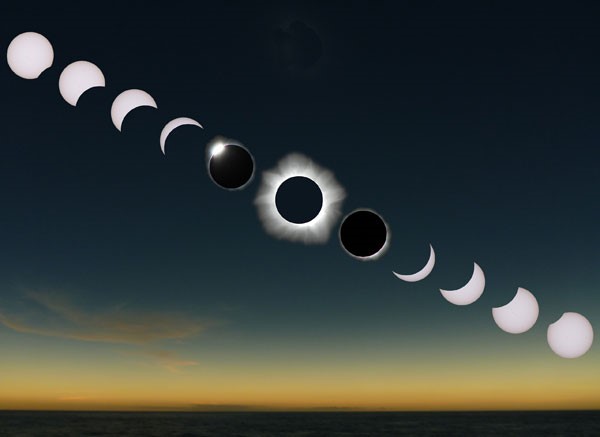
(https://skyandtelescope.org/2017-total-solar-eclipse/what-to-look-for-when-total-solar-eclipse/)
directly across the circle of the Sun’s face from where it was seen previously) and then at third contact, the Sun starts to become visible again as a partial eclipse, and the chromosphere and corona quickly fade away from view. A partial eclipse, with the Moon gradually revealing pulling back to reveal more and more of the Sun occurs over a time that, depending on the distance to the Moon and an observer’s location on Earth, can last an hour or more. Finally, the Moon is no longer blocking the Sun, reaching a moment known as Fourth Contact, and the eclipse is over.
Rarity of Seeing a Solar Eclipse. The area that actually experiences a total solar eclipse is very small. As a result total solar eclipses are exceedingly rare events at any given location. Even though a solar eclipse occurs somewhere on the Earth every six months or so, the odds of your particular location experiencing a total solar eclipse are actually quite small. For example, the Los Angeles area will not have its next total solar eclipse until sometime after the year 5000! Consider the map below that shows the paths of all the total solar eclipses on Earth from 2021 – 2040.
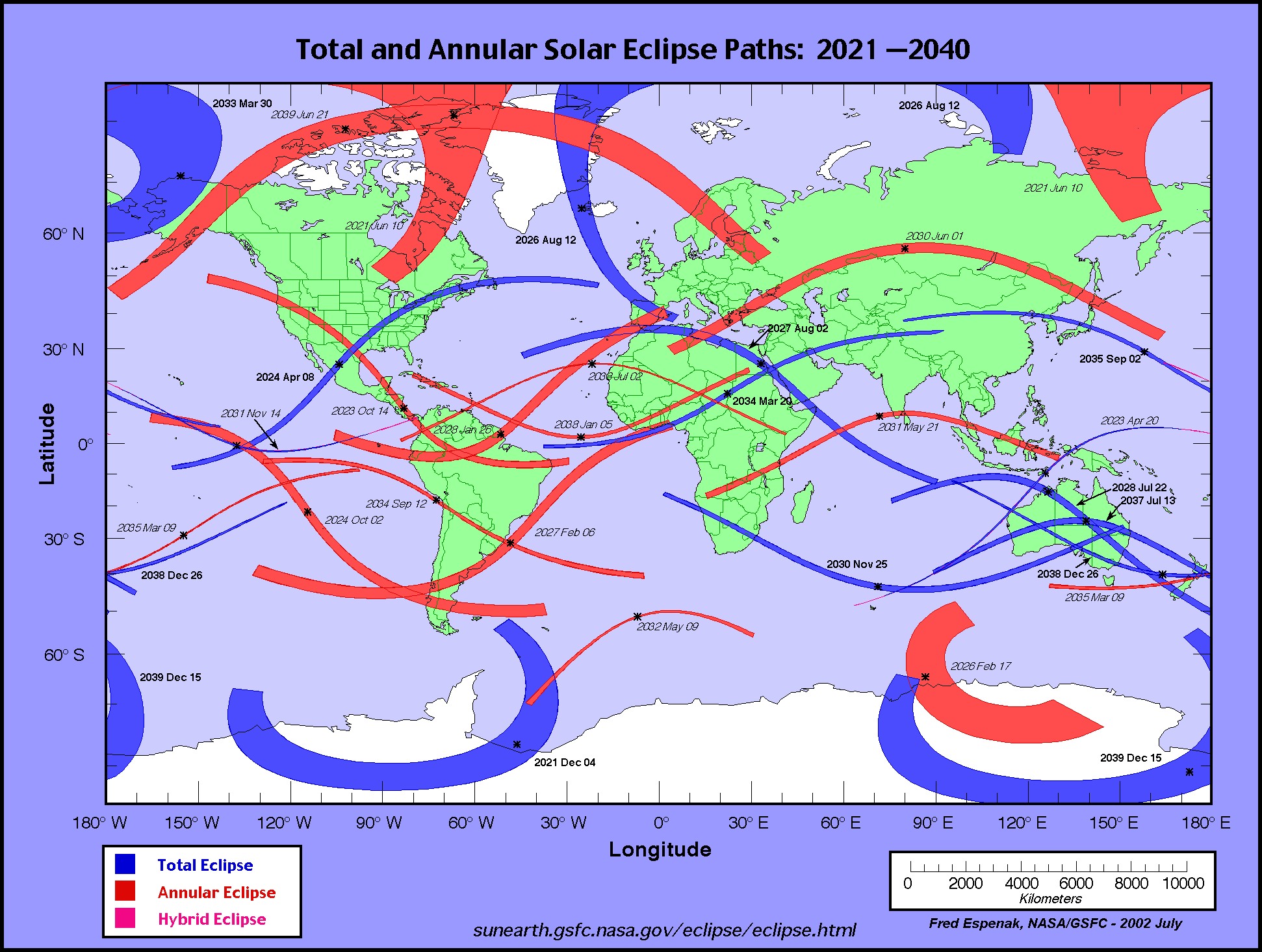
(credit is given at the bottom of the image)
As you can see from the image, only a select few portions of the globe get to experience a total solar eclipse. Two comments about the image above would be helpful I think. 1) The eclipses are color-coded based on what type of eclipse they are. The ones in blue are the total solar eclipses while the ones in red are annular solar eclipses, which we will discuss later. Only the total solar eclipses get to experience darkness and stars in the middle of the daytime and seeing the Sun’s corona, making the area on Earth that gets to experience these amazing eclipse events even smaller than it appears from the image above. 2) While it looks like areas near the North and South Poles have larger areas that experience the eclipses, this is just an effect created by taking a three-dimensional globe and projecting it onto a two-dimensional image. The areas for a total solar eclipse are still less than 150 miles for all total eclipses, no matter where they fall on the Earth.
Due to the rarity of these total solar eclipses, a whole cottage industry has sprung up around eclipses offering trips around the world to experience total solar eclipses. Just like a major sporting event or cultural event, for some these total eclipses are events that they must simply be at, even if it involves traveling great distances. An important factor that must be considered by anyone planning a trip to see a total solar eclipse, however, is weather. A day with clouds blocking the Sun means that you will notice the sky has gotten dark and then light again, but you will miss all the incredible light show that goes with an eclipse. Also, these eclipses move fast enough that there is not time to move to a new location if the spot you have chosen doesn’t work out. So, eclipse travelers often look over centuries of historical weather data trying to figure out how frequently an area might have had cloudy weather in the days around the upcoming total eclipse and at the times the eclipse is happening.
Partial Eclipses. What if you are not able to get to that small area where a total eclipse is occurring but you happen to live relatively close by (say within 1000 miles or so)? All is not lost because in this case you will still get to experience a partial solar eclipse. A partial solar eclipse is when some of the Sun is blocked but not all of it. So an area not too far from the total eclipse area might be able to see the Moon blocking 95% of the Sun and would notice the sky getting dimmer like right after sunset or before sunrise, but would not experience the total darkness of a total solar eclipse and the visibility of the corona. Consider again the image from the start of this article that shows the path of the Total Solar Eclipse of April 8, 2024. The light blue lines show where partial eclipses will be visible with each line marking a decreasing amount of the Sun that will be blocked as you move away from the total eclipse center. The light blue line closest to the total eclipse area is where 80% of the Sun will be blocked, the next line out is where 60% of the Sun will be blocked, all the way down to the outermost light blue lines outside of which there will be no partial eclipse visible. So, the closer you can get to the total eclipse area, the better your viewing experience will be. If you are viewing a partial solar eclipse, the progression of the eclipse will be very similar to that described above for a total solar eclipse with the notable exception that there will not be the total eclipse portion where the sky goes dark, a diamond ring could appear, or the corona is visible. The Moon will appear to slowly cover more and more of the Sun until it reaches its peak partial eclipse and then the Moon will seem to reveal more and more of the Sun until the partial eclipse ends.
Annular Solar Eclipses. Not every solar eclipse is a total solar eclipse, even if you can get to the optimal viewing location for the eclipse. Some solar eclipses, instead of being total solar eclipses, are known as annular solar eclipses. During an annular solar eclipse, instead of totality where the Moon is completely blocking the Sun, instead the Moon appears to be sitting right in the middle of the Sun and a ring of sunlight is visible around the Moon. This ring of sunlight is different from the corona. This ring is part of the photosphere, the bright main part of the Sun. Therefore, during an annular solar eclipse an observer will not notice the sky getting completely dark and will not be able to see the corona of the Sun. Consider the picture of the Moon and Sun during an annular solar eclipse below.
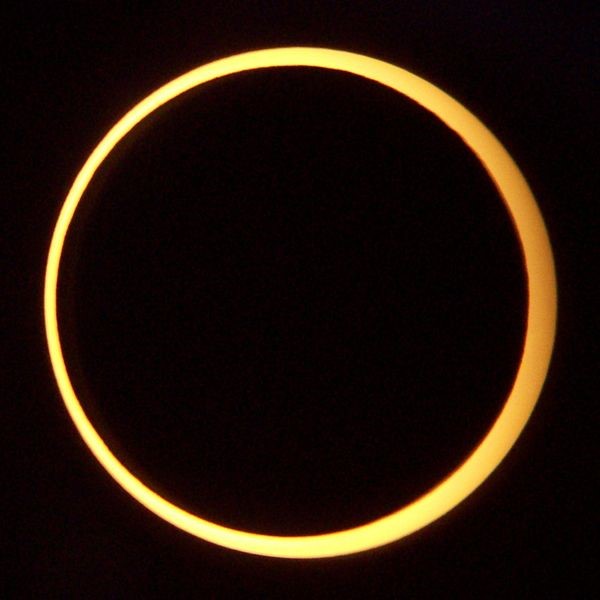
What causes some eclipses to be total and others to be annular? It has to do with this important fact: The Moon’s orbit around the Earth is elliptical with a higher eccentricity to the Earth’s orbit around the Sun. This means that the distance from the Earth to the Moon changes more significantly during the course of its orbit, ranging from 363,400 km at its closest to 405,500 km at its farthest. When the Moon is close to the Earth, the Moon takes up enough space in the sky to completely cover the Sun and therefore cause a total solar eclipse.. However, when the Moon is farther from the Earth, its angular size (the angle in the sky that the Moon takes up) is smaller and is, in fact, smaller than the Sun’s angular size. Therefore, the Moon is not taking up a sufficiently large enough part of the sky to block out the Sun completely, and you have an annular solar eclipse instead. As an interesting aside, we are fortunate to have total solar eclipses at all. Due to the tidal effects that the Moon creates on the Earth, the Moon is slowly getting farther from the Earth and eventually it will never be close enough to completely block out the Sun. At this point, all we will have are annular solar eclipses and there will be no total solar eclipses. Don’t worry too much, however, because it is estimated that this will occur approximately 560 million years from now (https://spacemath.gsfc.nasa.gov/weekly/4Page28.pdf). Until then we can go on enjoying both total solar eclipses and annular solar eclipses.
Earlier in the article, there was an image of the paths of solar eclipses for 2021 – 2040. The paths were color-coded based on the type of eclipse, and the red paths are annular solar eclipses, while the blue paths are total solar eclipses. Total solar eclipses and annular solar eclipses are approximately equal in number, so you can expect about the same number of total solar eclipses and annular solar eclipses paths on this map.
Frequency of Solar Eclipses. How often do solar eclipses happen on the Earth? For reasons we will see later in this article, conditions are right for a solar eclipse approximately every 6 months. Technically the time frame is every 173 days, which is just shy of 6 months. In the majority of these times, there will be a total solar eclipse or an annular solar eclipse, although there are some times when the conditions only allow for a partial solar eclipse to be seen on the Earth. In general, though, it is safe to assume and remember that a solar eclipse (usually total or annular) occurs somewhere on the Earth every 6 months. Despite this relatively high frequency of solar eclipses, it is the narrow path on the Earth that an eclipse takes that makes these events so rare for any specific place on the Earth and makes them a worthy and exciting travel destination.
Lunar Eclipses
Not nearly as spectacular as their cousins the solar eclipses, lunar eclipses nevertheless remain a very engaging light show in the sky and one that, as we shall see, can be much more frequently seen in any given location. Just as in a solar eclipse, the Sun is the object being blocked. However, in a lunar eclipse, it is the Moon that is being blocked. What is doing the blocking this time? It is the Earth. The Earth comes directly in between the Sun and the Moon and the Earth’s umbra now falls on the Moon.
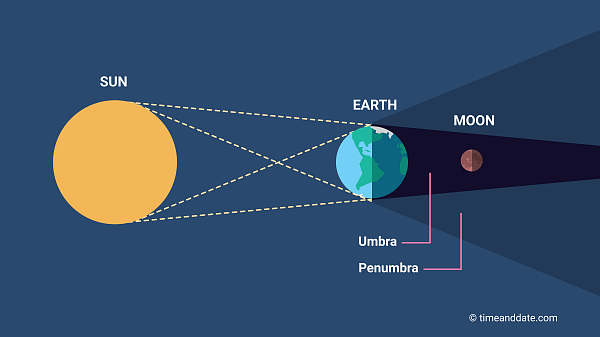
(source: https://www.timeanddate.com/eclipse/total-lunar-eclipse.html)
Consider the diagram above. The Earth casts a large shadow, much larger than the Moon does, which is not surprising since the Earth is also significantly bigger than the Moon. When the Moon happens to pass through the umbra of the Earth, we get what is known as a total lunar eclipse. In the diagram above, there is an area also labeled the Earth’s penumbra. The penumbra is the area where some of the Sun is blocked and if the Moon passes through the penumbra it is somewhat akin to a partial solar eclipse.
How does a lunar eclipse look from here on Earth? The Moon, which as we shall see later, is always a full Moon during a lunar eclipse, will gradually see its area lit by the Sun decreasing as it moves into the Earth’s shadow. In what looks a lot like the partial eclipse stage of a solar eclipse, more and more of the lit part of the Moon will become unlit, until at the moment that totality begins, the entire Moon will be in the region in space unlit by the Sun, just like in a total solar eclipse. The total lunar eclipse will last from anywhere between a few minutes to two hours and then more and more of the Moon will return to being lit by the Sun until after a couple of hours more, the entire full Moon has returned.
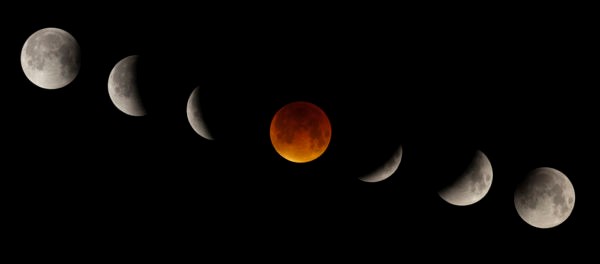
(source: https://skyandtelescope.org/press-releases/all-you-need-to-know-for-sundays-total-lunar-eclipse/)
In the image above, we see the stages of a total lunar eclipse. In this image it is clear that something unique and very different from a total solar eclipse is happening during the total lunar eclipse stage. During a total lunar eclipse, the Moon takes on an eerie, red glow to it. For this reason, lunar eclipses are sometimes colloquially referred to as “blood moons”. While not obvious in the picture, the overall brightness of the total lunar eclipse stage is significantly lower than the overall brightness of the Moon during a full Moon or even during the stages of the partial lunar eclipse leading up to and immediately following the “blood moon”. What causes the red glow of the Moon during a total lunar eclipse? If you think about it for a minute, it does not make sense. If the Moon is completely in Earth’s shadow or umbra during a total lunar eclipse, then NO light should be reaching it from the Sun and therefore the Moon should look completely dark. The reason why the Moon takes on a red glow during the time of totality in a lunar eclipse has everything to do with the Earth and in particular with the fact that we have an atmosphere. When light from the Sun comes into our atmosphere, two things primarily happen to it. One of these is that the light is scattered or bounced around in the atmosphere in all directions. Shorter wavelength light, such as blue and violet, get scattered the most. This scattering, incidentally, is what gives the sky its blue color. All the blue light from the Sun is bouncing around our atmosphere – bouncing so much that it eventually appears to be coming from all directions – and so as we detect this blue light with our eyes we see a blue sky. Red light is still scattered by our atmosphere but to a lesser degree. This scattering is the reason why, when the Sun is low in the sky such as sunrise or sunset, parts of the sky near the Sun will often take on a reddish hue. The fact that this only happens when the Sun is low in the sky (and therefore light has more atmosphere to travel through) and that it is not the entire sky but only a portion of the sky near the Sun that turns red is because red light is scattered much less than blue light. The effect of scattering means that very little blue light that goes through our atmosphere emerges on the other end – almost all is scattered away. Red light, however, can still largely get through. The fact that red light can get through is part of the answer to our puzzle of why the Moon looks red during a lunar eclipse, but it does not explain how the Moon gets red light to reflect during a total eclipse when it is sitting in the umbra of the Earth. This fact is explained by the second process going on in Earth’s atmosphere, refraction. Light is not only scattered when it comes through the atmosphere, but that light which manages to get through without being scattered is also refracted or bent. This refraction is also what occurs when light goes through a prism and is separated out into the colors of the rainbow as the light bends when it passes through the glass. During an eclipse, the red light that gets through is bent and it is bent by enough that some of it manages to hit the surface of the Moon, giving the Moon its red appearance. You’ll notice that the red Moon is much fainter than a normal full Moon, which makes sense because during a full Moon all the light from the Sun is hitting the Moon, while during a total lunar eclipse only a small portion of the light hits the Moon. How much red light hits the Moon during a total lunar eclipse also varies and is in some ways unpredictable. Depending on what type of particles and particulates are in the Earth’s atmosphere at the time, more or less of the red light is scattered, which means more or less of the red light gets through our atmosphere. If the atmosphere is particularly polluted, say after a major volcanic eruption, it is possible that very little red light will get through and the Moon will appear more totally dark during the total lunar eclipse stage.
Frequency of Lunar Eclipses. Just like solar eclipses, conditions are ripe with the positions of the Earth, Moon, and Sun to get a lunar eclipse approximately every 6 months. A total lunar eclipse does not occur every 6 months. Sometimes the conditions are only appropriate for a partial lunar eclipse to occur, where some of the Moon will be in the Earth’s umbra but not all of it. In these cases you will likely not see the red Moon effect but rather a portion of the Moon that does not appear as lit as the rest of the Moon. Occasionally, not even a partial solar eclipse will occur. Sometimes, none of the Moon completely passes into the Earth’s umbra. Instead the Moon is sitting in the penumbra of the Earth where the Earth is blocking some of the Sun but not all of the Sun. In these cases, all that happens is that the overall amount of light from the Sun that is hitting the Moon diminishes and the Moon looks overall fainter in the sky. It is quite possible to miss one of these eclipses, called a penumbral lunar eclipse, completely as the effect is not nearly as dramatic as a total or partial lunar eclipse. A big difference between solar and lunar eclipses exists, however, in how frequently they are seen by a particular location on the Earth. While solar and lunar eclipses both occur every 6 months somewhere on the Earth, the narrow path of a solar eclipse means only a small fraction of the Earth gets to experience it. On the other hand, at any given moment, half of the Earth can see the Moon. If you are on the side of the Earth that is facing the Moon, you will see the Moon, and by implication, also see the lunar eclipse as it is happening. Since over half the Earth can see a lunar eclipse, it means that lunar eclipses are much more common in any given area. On average a lunar eclipse of some sort is visible approximately every year at any particular location on the Earth, making these events, exciting though they may be, less of the spectacle that a solar eclipse is. It is very unlikely someone would travel great distances to see a lunar eclipse, for example.
When Do Eclipses Occur? If we look at the diagrams above of the positions of the Moon, Earth, and Sun during a total solar eclipse and a total lunar eclipse, it is possible to figure out whether there is a pattern for phases of the Moon when these types of eclipses occur. There is in fact a very clear pattern. Solar eclipses only occur during new Moon and lunar eclipses only occur during full Moon. In order for a solar eclipse to occur, you need the shadow of the Moon to be falling directly onto the Earth, which means that the Moon must be exactly in between the Earth and the Sun. This needs a new Moon setup where the Moon is occupying the same direction in space as the Sun. It also makes sense in explaining when solar eclipses occur. During a new Moon, the Moon is in the sky during the day time. This is exactly when solar eclipses must occur, since in order for the Sun to appear blocked the Sun must be in the sky, which means it is daytime. Likewise, for the Earth’s shadow to fall onto the Moon, the Moon must be on the opposite side of the Earth from the Sun. This gives us a full Moon and also matches with what we observe. Since lunar eclipses occur at night time, the Moon must be on the side of the Earth where the Sun is not visible, which would suggest a full Moon. Both a full Moon and a new Moon occur on the Earth every 29-30 days (or approximately every month). However, as we saw above, solar and lunar eclipses only happen approximately every 6 months.
What is going on to prevent the eclipses from coming around EVERY full Moon and new Moon? The answer to this question lies in the fact that the Moon orbits the Earth with a small inclination to its orbit compared with the orbit of the Earth around the Sun. This inclination is small, only about 5 degrees, but it is enough to prevent eclipses from happening every new Moon and full Moon. In order to get an eclipse, the Earth, Moon, and Sun need to line up in an exactly (or almost exactly) straight line. Consider the image below of the Moon orbiting the Earth while the Earth goes around the Sun and look at the diagram on the left of the image. Where would the Moon be for a new Moon? It would be when the Moon is on the left of its orbit, but in this case this also means that because of the inclination of the Moon’s orbit, it is located below the line between the Earth and the Sun. The Moon’s umbra now falls into empty space below the location of the Earth and there is no solar eclipse. Two weeks earlier or later, when the Moon is on the opposite side of the Earth and in a position for a full Moon, now the Moon is above the line between the Earth and the Sun. The Earth’s shadow falls below the Moon and there is no lunar eclipse either. Now, consider what happens three months later, which is the diagram at the bottom of the image. The direction of the Moon’s inclination stays the same as the Moon orbits the Earth and the Earth orbits the Sun, so now situations are slightly different. When it is a new Moon, the Moon is now located directly (or very close to) the line between the Earth and the Sun. This means that the Earth, Moon, and Sun are all in a straight line (or close to a straight line) and the Moon’s umbra now falls on the Earth, giving us a solar eclipse. Similarly, two weeks earlier or later, when the Moon is in a full Moon position, the Sun, Earth, and Moon are once again in a straight line and the umbra of the Earth falls directly on the Moon, producing a lunar eclipse. As the Earth continues to orbit the Sun, the Moon’s inclination causes the Sun, Moon, and Earth to be out of alignment again, until 6 months later (the top diagram in the image) they are lined up again and the Earth will experience a solar and lunar eclipse. This 5 degree inclination, as small as it might seem, explains why eclipses occur approximately every 6 months. If there was no inclination to the Moon’s orbit, then eclipses would be much more common with a solar and lunar eclipse happening every month. This inclination also explains an interesting fact about eclipses. They always come together – when there is a solar eclipse, either two weeks earlier or two weeks later there was or will be a lunar eclipse and vice-versa. If the conditions and alignments are right for one type of eclipse, then they will also be right for the other kind of eclipse.
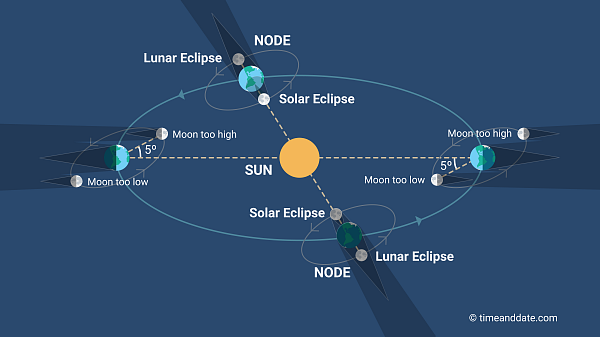
(Source: https://www.timeanddate.com/eclipse/how-often-solar-eclipse.html)
Conclusion: Eclipses are spectacular events that generate attention worldwide. Solar eclipses are especially rare and impressive, and these often become events where people will travel long distances to experience totality and to see stars in the middle of the daytime, to see the Sun getting “swallowed up” by the Moon, and to observe the corona and diamond ring effect. Lunar eclipses, while not quite as impressive, are still often ominous events with a light red glowing Moon dominating an evening or early pre-dawn morning sky. An eclipse can also make for a confusing topic to cover in an introductory Astronomy class. There are so many terms and concepts related to eclipses that, just as ancient peoples were often scared at the temporary disappearance of the Sun, it can be scary to study now. If you are feeling that eclipse phobia happening in your astronomy class, don’t despair and give up hope. Let us help you at 24houranswers.com – we have professional astronomers and astronomy educators here ready to help you through all the different components of an eclipse. We can help you master this material, freeing you up to enjoy eclipses as the awe-inspiring events that they really are. Reach out to us today!